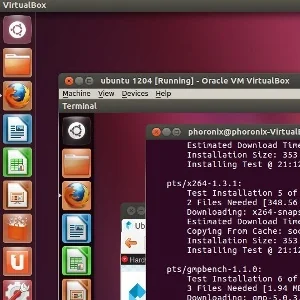VMware's Gallium3D Driver For Virtualization

Compared to Oracle's VM VirtualBox graphics acceleration support that is quite slow for OpenGL and often unreliable or the limited attempts at OpenGL QEMU acceleration, VMware has a rather nice acceleration architecture built atop Gallium3D. Using Gallium3D at the heart of their graphics driver implementation across platforms shouldn't be surprising though since they bought out Tungsten Graphics in late 2008 and its these Mesa / Gallium3D drivers now developing VMware's graphics stack.
VMware's Gallium3D driver known as "vmwgfx" for its "SVGA II adapter" is open-source for its kernel and Gallium3D bits. The kernel DRM / libdrm / Mesa bits are all living in the respective mainline trees and are open. Just not being open is VMware's virtualization platform itself. With the vmwgfx DRM driver is also kernel mode-setting support.
While the vmwgfx stack is open-source, it's not enabled by default in Ubuntu and many other Linux distributions at this time. This Gallium3D stack for VMware virtualization came about in 2009 and has matured since.
With leveraging the Gallium3D architecture, guest operating systems using the Gallium3D user-space driver for this VMware SVGA II adapter can benefit not only from OpenGL acceleration but also closed-source Direct3D acceleration, EXA / X-Video acceleration on the Xorg state tracker, and state trackers for OpenGL ES 1.1/2.0 and OpenVG. State trackers for H.264 VDPAU and OpenCL are also on the road-map for Mesa, as Phoronix readers should already know.
The VMware Linux driver is quite stable and nice from the tests that I have carried out. It's capable of handling Compiz / KWin / GNOME Mutter and various OpenGL games. There really aren't any complaints that I have and their bits are mainline and open-source. It should also be possible to run Wayland on this driver stack, but that's been untested as of right now.
As to those in the Phoronix Forums wondering why this VMware driver is never benchmarked, it comes down to a few key reasons: 1. VMware's virtualization licenses are CPU-locked and expensive (VMware in the past has offered a license or two just for review) and 2. VMware's user agreement bans any benchmarks from taking place and being published of their virtualization system (at least as far from publishing the results on mainstream, frequently-visited sites like Phoronix). Those are the two key reasons. It's a pity as its under VMware that I run my main desktop and is the best virtualization platform I've used, especially when it comes to graphics acceleration and support.
Fortunately, at least, there are independent users willing to benchmark VMware on OpenBenchmarking.org. A few more vmwgfx comments can also be found in the forums.
14 Comments

